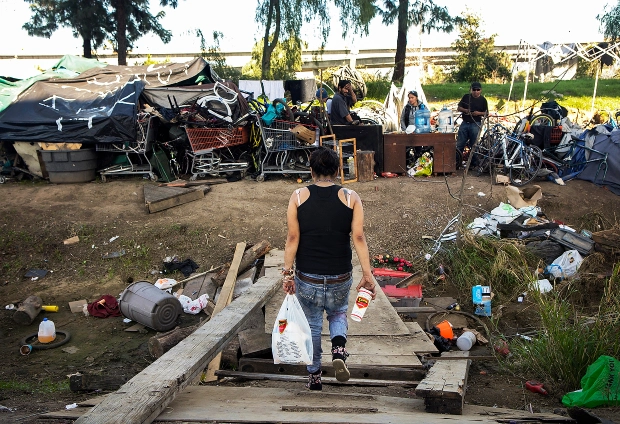Santa Clara County reports 1% dip in homeless population

Despite moving thousands of homeless people into permanent homes last year, Santa Clara County saw its unhoused population remain virtually unchanged, even as the number of homeless families spiked, according to preliminary results from its latest “point-in-time” count.
The count, taken on a single night in January, identified 9,903 people living outdoors, in vehicles or in homeless shelters across the county. That was a 1% dip from the more than 10,000 homeless people counted at the start of last year.
While the county housed around 3,600 homeless people over the course of 2022, officials said it wasn’t enough to overcome rising economic inequality and a severe shortage of affordable housing at the root of homelessness in the Bay Area.
“People are still falling into homelessness faster than we can house in any given year,” said KJ Kaminski, deputy director of the county’s Office of Supportive Housing.
At first glance, the most alarming figure in the results appears to be the 1,226 homeless people in families with children, a 37% spike from last year. In San Jose, that sub-population more than doubled to 891.
But officials said the increase was expected thanks to new efforts to connect with homeless families who are often reluctant or unable to reach out for help on their own. Almost all homeless families identified in the count had been placed in shelters, officials said.
“There’s shame associated with being connected to services,” said Consuelo Hernandez, county supportive housing director. “And also, you’re in crisis and have children.”
The count results come as frustration mounts over officials’ response to homelessness, as residents feel the crisis is worsening despite a flood in state and local spending in recent years to boost services and create new shelters and supportive housing.
While Santa Clara County’s homeless population increased only 3% during the pandemic despite widespread job losses, officials said the impact of COVID-19 continues to be felt on everything from helping unhoused people find jobs and housing to the time it takes to build shelters.
The county’s latest count determined that about two-thirds of its homeless population lived in encampments or other places not meant for habitation, while the rest were staying in shelters. The number of unsheltered people in the county dipped 4% to 7,401.
San Jose saw its homeless population drop nearly 5% from last year to 6,340 people, making up 64% of the county’s unhoused population. The count found 4,411 unsheltered people in the city, a nearly 11% decline.
New Mayor Matt Mahan, who’s made reducing homeless encampments a centerpiece of his first term, attributed the decrease in unsheltered homelessness to the hundreds of tiny homes, prefabricated cabins and other “interim” shelter units the city has built in recent years.
Unlike dorm-style shelters, San Jose’s interim sites provide individual rooms to give residents more privacy and stability. The hope is that unhoused people are more likely to accept the shelter and can better take advantage of services, including help finding permanent housing.
Half the roughly 900 people who stayed at the city’s interim shelters last year moved into permanent homes, though results varied widely across the seven shelter sites. Some sites had a maximum stay of six months, while others allowed residents to stay a year or more.
Mahan is doubling down on that approach, asking the city to set aside $50 million to help add 1,000 new interim shelter beds this year while also expanding no-encampment zones throughout the city. Advocates have criticized the proposal, arguing the city should instead focus that investment on low-income and supportive housing.
“In the long run, we need a lot more housing, especially a lot more affordable housing,” Mahan said. “In the short run, I would argue, and maybe not everyone would agree, that I would have a bias toward trying to get people out of encampments as fast as possible.”
Santa Clara County moved forward with this year’s count even though most Bay Area counties aren’t scheduled to do their next counts until 2024. Officials said this year’s tally was meant to make up for the 2021 count, which was canceled because of the pandemic. The county will now do its count every odd year going forward.
More detailed results from this year’s count will be available in the coming months.
Officials acknowledge homeless counts — conducted by teams of volunteers — provide merely an estimate rather than a precise census. But they give cities and counties the clearest understanding of their homeless populations and help determine how much federal funding they receive for homelessness programs.
Earlier this month, Mahan and the mayors of California’s largest cities — including mayors Sheng Thao of Oakland and London Breed of San Francisco — visited Sacramento to ask for a guaranteed $2 billion in state homelessness funding each year, instead of one-time grants and programs launched by Gov. Gavin Newsom in recent years.
Hernandez with the supportive housing office said more ongoing and predictable funding streams will be essential to following through on the county’s new efforts to alleviate the crisis.
“That would actually allow us to plan and project out: How do we sustain the system that we built?”

